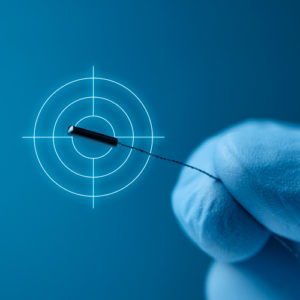Home > Technology Comparison
Technology Comparison
The Polaris® optical measurement solution, and Aurora® and 3D Guidance® electromagnetic tracking solutions, provide distinct technology advantages to fulfill the many aspects of OEM surgical navigation systems and application workflows. The tracking environment, the required medical instruments, operative setup, accuracy thresholds, and desired application outcomes are just some of the requirements that must be considered.
What’s more, the combination of these factors is unique to each OEM medical device manufacturer. It’s why we offer our 3D measurement and tracking technology solutions in different form factors and configurations, each with diverse customization and integration options – to help our OEM customers achieve almost any tracking application, including those not yet imagined.
The below comparison charts outline the basic differences between optical measurement and electromagnetic tracking technologies.
Related Article:
Optical Measurement
Technology Advantages
- Exceptional sub-millimetre accuracy
- Large measurement volume
- Wireless tracking
- Reliable measurement data quality
- Stable performance in most clinical environments
- Easy-to-design tools
Technology Limitations
- Line-of-sight required
- Best suited to use with larger tools, which can impede clinical workflow
- Reflectivity of contaminated markers can reduce accuracy
- Tools must be rigid, with the tool tip fixed relative to markers
Polaris Vega
Polaris Lyra
Electromagnetic Tracking
Technology Advantages
- No line-of-sight required; allows for in-vivo tool tracking
- Sensors can be embedded into flexible or rigid tools
- Sensors can be placed at the tip of flexible tools or needles
- Small sensor sizes allow for integration into tools with minimal change to tool form factor
- Most components integrate directly inside OEM system or cart
Technology Limitations
- Can be less accurate than optical measurement
- Smaller tracking volume than optical measurement
- Sensors must be wired
- Susceptible to environmental interference
- Measurement data quality can be distorted in the presence of conductive and/or ferromagnetic metals
Aurora
3D Guidance

Why Accuracy Matters
Learn about the importance of accuracy in optical measurement and electromagnetic tracking.
Legal Disclaimer
NDI tracking and measurement products are general metrology components that can be integrated into customer products, research experiments, and/or as components of medical devices that require precision measurement and tracking. While NDI components and technology can be integrated into original equipment manufacturer (OEM) medical devices, they are not specifically intended for a given application and, as such, have not been developed or manufactured in accordance with medical device standards. It remains the responsibility of the OEM customer or end-user to determine and test the suitability of NDI components and technology for their intended use, including performing any required ethics approval, verification, and validation required to demonstrate suitability and compliance. System-level testing, certification, and validation are the responsibility of the original equipment manufacturer or the applicable end-user and should be completed prior to the use of NDI products or technologies in any application.